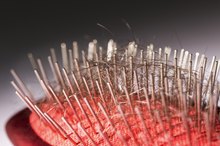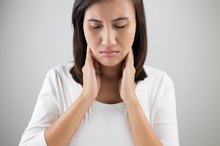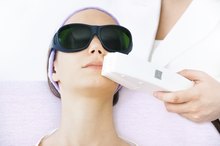The Effects of Woman Using Rogaine for Men
There are many reasons women lose their hair including menopausal complications and alopecia areata, an inherited condition that results in thinning hair and patchy hair loss 4. Minoxidil, the active ingredient in Rogaine for men, was approved for women's use at the 2% concentration in 1991, though the more potent 5% dose approved for men in 1997 has yet to gain FDA approval for use in women 3.
Efficacy
In a double-blind study conducted by Anne W. Lucky, MD, et al and published in the Journal of the American Academy of Dermatology in 2004, the 5 percent treatment group showed statistically significant improvement over the placebo and 2 percent solution groups 5. The study evaluated effects on three end points: nonvellous hair growth, scalp coverage and patient perception of hair growth, an analysis of the psychosocial effect of female pattern baldness.
Low Blood Pressure
The Best Hair-Loss Products for Women
Learn More
A side effect of any minoxidil for women is slightly lowered blood pressure, and using the 5 percent solution prescribed to men can intensify that affect. Low blood pressure can cause dizziness, fatigue or even fainting upon standing if the use of Rogaine for men is not discontinued.
Unwanted Hair Growth
Many women using the five percent Rogain for men experience unwanted hair growth, usually on the face. Some of this is due to the product dripping down to the face after application, but even careful use cannot prevent the effect entirely as the minoxidil enters the blood stream through contact with the scalp.
Pregnancy and Nursing
Difference in Rogaine for Men & Women
Learn More
Minoxidil falls into the U.S. Food and Drug Administration’s category “C,” meaning that in some animal studies, there have been adverse effects on the fetus, but there are no reliable human trials with pregnant women. Category “C” drugs should be avoided by pregnant women unless the benefits far outweigh the risks. Nursing mothers are also advised against using Rogaine in the company’s literature as the drug is transmitted through breast milk. The patient should either discontinue Rogaine use or discontinue nursing depending upon treatment need.
- Minoxidil falls into the U.S. Food and Drug Administration’s category “C,” meaning that in some animal studies, there have been adverse effects on the fetus, but there are no reliable human trials with pregnant women.
- Nursing mothers are also advised against using Rogaine in the company’s literature as the drug is transmitted through breast milk.
Related Articles
References
- Androgenetical Allopecia: Minoxidil for the Treatment of Female Pattern Hair Loss
- Medicine Net: Rogaine
- Medicine Net: Alopecia Areata
- Journal of the American Academy of Dermatology: Trial of 5 Percent and 2 Percent Minoxidil Solutions: Female Pattern Baldness
- Pharmacia & Upjohn Company. Loniten minoxidil tablets, USP. Updated January 2015.
- No author listed. Topical minoxidil approved by FDA. Clin Pharm. 1988;7(12):858,862.
- Center for Drug Evaluation and Research. Application number: NDA 20-834. October 1, 1997.
- Ustuner ET. Cause of androgenic alopecia: crux of the matter. Plast Reconstr Surg Glob Open. 2013;1(7):e64. doi:10.1097/GOX.0000000000000005
- Suchonwanit P, Thammarucha S, Leerunyakul K. Minoxidil and its use in hair disorders: A review. Drug Des Devel Ther. 2019;13: 2777-86. doi:10.2147/DDDT.S214907
- Johnson & Johnson. Product monograph: Rogaine topicsal 2% solution: Minoxidil topical solution 20 mg/mL (2% w/v), Rogaine foam 5%: Minoxidil foam 50 mg/g (5% w/w), Women’s Rogaine foam 5%: Minoxidil Foam 50 mg/g (5%w/w). Updated July 20, 2014.
- Darwin E, Hirt PA, Fertig R, Doliner B, Delcanto G, Jimenez JJ. Alopecia areata: Review of epidemiology, clinical features, pathogenesis, and new treatment options. Int J Trichology. 2018;10(2):51-60. doi:10.4103/ijt.ijt_99_17
- Braam B, Taler SJ, Rahman M, et al. Recognition and management of resistant hypertension. Clin J Am Soc Nephrol. 2017;12(3):524-35. doi:10.2215/CJN.06180616
- Slove S, Lannoy M, Behmoaras J, et al. Potassium channel openers increase aortic elastic fiber formation and reverse the genetically determined elastin deficit in the BN rat. Hypertension. 2013;62(4):794-801. doi:10.1161/HYPERTENSIONAHA.113.01379
- Jimenez-Cauhe J, Saceda-Corralo D, Rodrigues-Barata R, et al. Effectiveness and safety of low-dose oral minoxidil in male androgenetic alopecia. J Am Acad Dermatol. 2019;81(2):648-9. doi:10.1016/j.jaad.2019.04.054
- Shah NH, Ruan DT. Pheochromocytoma: a devious opponent in a game of hide-and-seek. Circulation. 2014;130(15):1295-8. doi:10.1161/CIRCULATIONAHA.114.008544
- Rossi A, D'arino A, Pigliacelli F, et al. The diagnosis of androgenetic alopecia in children: Considerations of pathophysiological plausibility. Australas J Dermatol. 2019;60(4):e279-e283. doi:10.1111/ajd.13079
- Mundt HM, Matenaer M, Lammert A, et al. Minoxidil for treatment of resistant hypertension in chronic kidney disease--A retrospective cohort analysis. J Clin Hypertens (Greenwich). 2016;18(11):1162-7. doi:10.1111/jch.12847









